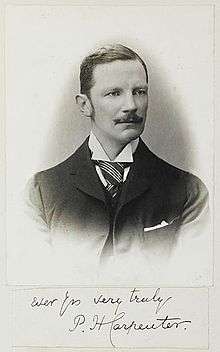Philip Herbert Carpenter
| Philip Herbert Carpenter | |
|---|---|
 | |
| Born |
6 February 1852 London, England |
| Died |
21 October 1891 (aged 39) Eton College, England |
| Cause of death | due to self-administration of chloroform during a bout of temporary insanity caused by chronic insomnia |
| Resting place | 51°34′01″N 0°08′49″E / 51.567°N 0.147°E |
| Nationality | British |
| Alma mater | |
| Occupation | British naturalist and crinoid authority |
| Years active | 1874–1891 |
| Title |
|
| Religion | Unitarian |
| Parent(s) |
Dr William Benjamin Carpenter, Louisa Powell (1840-1885) |
| Relatives |
Philip Pearsall Carpenter (uncle)) Russell Lant Carpenter (uncle) Mary Carpenter (Aunt) |
| Awards | Lyell Fund (1881) |
Philip Herbert Carpenter (6 February 1852 in London – 21 October 1891 in Eton College),[1] M.A., D.Sc., F.R.S., British naturalist and crinoid authority, was the fourth son of Dr. William Benjamin Carpenter.[2][3] He took his own life, by self-administration of chloroform during a bout of temporary insanity caused by chronic insomnia.[4]
Education and research
Carpenter was educated at University College School, then at University College, and afterwards became a Scholar of Trinity College, Cambridge, where he graduated in 1874.[5] He was a member of the scientific staff of the deep-sea exploring expeditions of H.M.S. Lightning (1868) and Porcupine (1869–1870). In 1875, he was appointed assistant naturalist to H.M.S. Valorous accompanying Admiral Sir George Strong Nares's Arctic expedition to Disco Island, and spent the summer sounding and dredging in Davis Strait and the North Atlantic.
Career
After the 1872-1876 HMS Challenger expedition had returned, he was asked in January 1878 by Sir Wyville Thomson to describe the free-swimming Crinoids that had been collected.
Dr. Carpenter was an expert on the morphology of the echinoderms, especially the crinoids, both contemporary and fossil. In 1883, he was awarded the Lyell Fund[6] by the Geological Society of London in recognition of the scientific value of his work, and in 1885 was elected a Fellow of the Royal Society.[7]
Publications
Carpenter published a large number of papers on Echinoderm and especially Crinoid morphology, in the Royal, Linnean, Geological, and Zoological Societies of London, the Quarterly Journal of Microscopical Science, the Annals and Magazine of Natural History, Zoologischer Anzeiger, and many other journals. He jointly authored the Catalogue of the Blastoidea in the British Museum with Mr. R. Etheridge, jun.
- 1882. On the Relations of Hybocrinus, Baerocrinus, and Hybocystites, Quart. Journ. Geol. Soc. vol. xxxviii. (No. 151), pp. 298–312, pi. xi.
- 1886. Note on the Structure of Crotalocrinus, Ann. Mag. Nat. Hist. ser. 5, vol. xviii. pp. 397–406.
- 1887. Notes on Echinoderm Morphology, No. 11; on the Development of the Apical Plates in Amphiura squamata, Quart. Journ. Micr. Sci. vol. xxviii. pp. 303–317.
- 1889. Report on the Comatulae of the Mergui Archipelago, etc., Journ. Linn. Soc. London (Zool.), vol. xxi. pp. 304–316, pis. xxvi. and xxvii.
- 1890. Preliminary Report on the Crinoidea obtained in the Port Phillip Biological Survey, Proc. Roy. Soc. Victoria, new series, vol. ii. pp. 135–136.
- 1890. On certain points in the Anatomical Nomenclature of Echinoderms, Ann. Mag. Nat. Hist. ser. 6, vol. vi. pp. 1–23.
- 1891. Some publications on American Carboniferous Echinoderms, Ann. Mag. Nat. Hist. ser. 6, vol. viii. pp. 94–100.
- 1891. On certain points in the Morphology of the Cystidea, Journ. Linn. Soc. London (Zool.), vol. xxiv. pp. 1–52, pi. i. Abstract in Rep. Brit. Assoc. for 1890, p. 821; and in GEOL. MAG. Dec. III. Vol. VIH. p. 135, March, 1891.
- 1891. Notes on some Arctic Comatulae, Journ. Linn. Soc. London (Zool.), vol. xxiv. pp. 53–63, pi. ii.
- 1891. Notes on some Crinoids from the Neighbourhood of Madeira, op. et torn. tit. pp. 64–69.
He also contributed an account of the Echinoderms to Cassell's Natural History (1883), and was the chief contributor for the section on the same group in Nicholson and Lydekker's A Manual of Palaeontology (1889).
Family
On 19 April 1879, he married Caroline Emma Hale, daughter of Edward Hale, an assistant master at Eton, by whom he had five sons, all surviving him.[2]
References
- ↑ "PHILIP HERBERT CARPENTER". Cambridge University. p. 573.
- 1 2 Bonney 1901.
- ↑ The Publishers' Circular and Booksellers' Record of British and Foreign Literature, Issue No. 1321, Oct. 24, 1891, p. 487.
- ↑ "Sleeplessness and Suicide," Grey River Argus (New Zealand), Volume XXXII, Issue 7315, 9 March 1892, p. 4.
- ↑ "Carpenter, Philip Henry (CRPR871PH)". A Cambridge Alumni Database. University of Cambridge.
- ↑ Award Winners Since 1831, Lyell Fund, http://www.geolsoc.org.uk/gsl/society/history/page5539.html, accessed 31 Oct 2010.
- ↑ Nature: A Weekly Illustrated Journal of Science, Issue of October 29, 1891, pp. 628-629.
- Attribution
 This article incorporates text from a publication now in the public domain: Bonney, Thomas George (1901). "Carpenter, Philip Herbert". In Sidney Lee. Dictionary of National Biography, 1901 supplement. London: Smith, Elder & Co.
This article incorporates text from a publication now in the public domain: Bonney, Thomas George (1901). "Carpenter, Philip Herbert". In Sidney Lee. Dictionary of National Biography, 1901 supplement. London: Smith, Elder & Co.  This article incorporates text from Men and Women of the Time, by G. Washington Moon, a publication from 1891 now in the public domain in the United States.
This article incorporates text from Men and Women of the Time, by G. Washington Moon, a publication from 1891 now in the public domain in the United States.